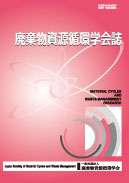Volume 21, Issue 5
Displaying 1-12 of 12 articles from this issue
- |<
- <
- 1
- >
- >|
Preface
-
2010Volume 21Issue 5 Pages 263-264
Published: 2010
Released on J-STAGE: December 19, 2014
Download PDF (196K)
Special Issues : Recycling of Waste Plastic Containers and Packaging
-
2010Volume 21Issue 5 Pages 265-272
Published: 2010
Released on J-STAGE: December 19, 2014
Download PDF (541K) -
2010Volume 21Issue 5 Pages 273-280
Published: 2010
Released on J-STAGE: December 19, 2014
Download PDF (342K) -
2010Volume 21Issue 5 Pages 281-287
Published: 2010
Released on J-STAGE: December 19, 2014
Download PDF (584K) -
2010Volume 21Issue 5 Pages 288-294
Published: 2010
Released on J-STAGE: December 19, 2014
Download PDF (385K) -
2010Volume 21Issue 5 Pages 295-299
Published: 2010
Released on J-STAGE: December 19, 2014
Download PDF (297K) -
2010Volume 21Issue 5 Pages 300-308
Published: 2010
Released on J-STAGE: December 19, 2014
Download PDF (748K) -
2010Volume 21Issue 5 Pages 309-317
Published: 2010
Released on J-STAGE: December 19, 2014
Download PDF (439K) -
2010Volume 21Issue 5 Pages 318-327
Published: 2010
Released on J-STAGE: December 19, 2014
Download PDF (421K)
Report
-
2010Volume 21Issue 5 Pages 328-334
Published: 2010
Released on J-STAGE: December 19, 2014
Download PDF (325K)
Activity Reports from the Regional Chapters
-
2010Volume 21Issue 5 Pages 335-337
Published: 2010
Released on J-STAGE: December 19, 2014
Download PDF (248K)
Book Review
-
2010Volume 21Issue 5 Pages 338-339
Published: 2010
Released on J-STAGE: December 19, 2014
Download PDF (161K)
- |<
- <
- 1
- >
- >|
